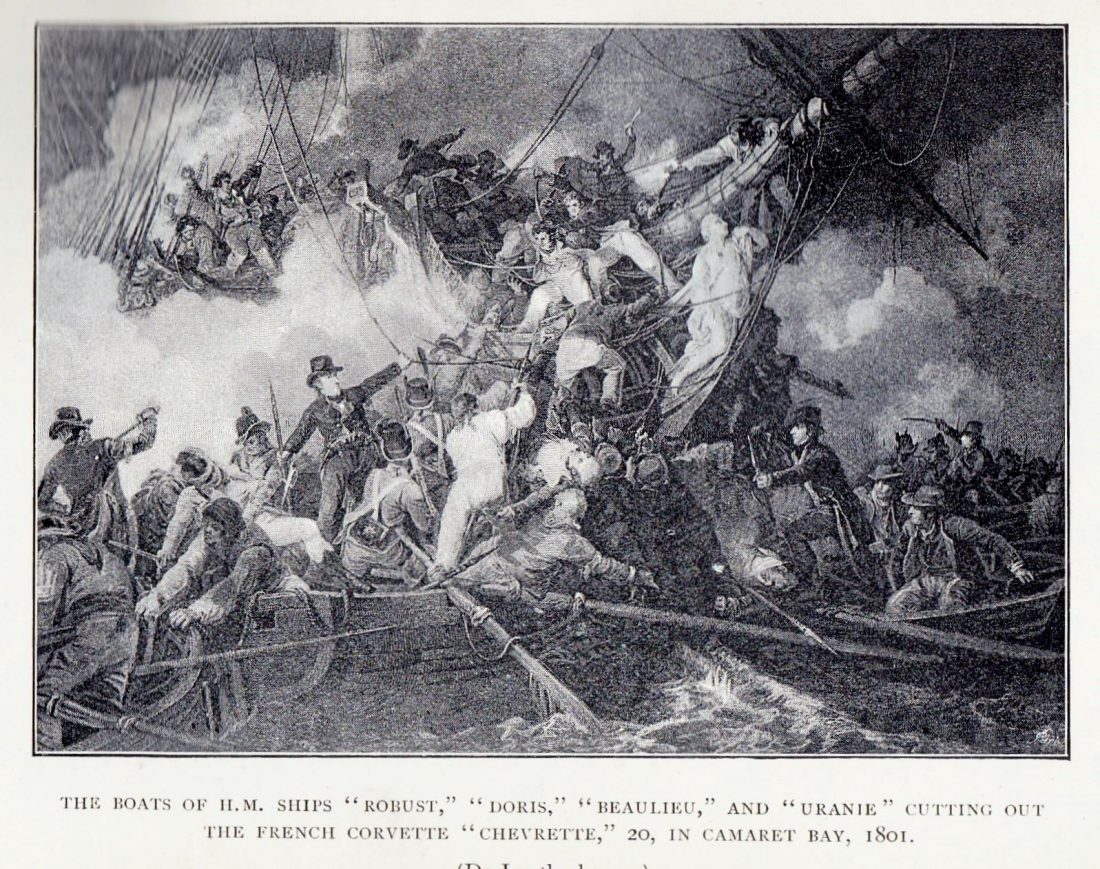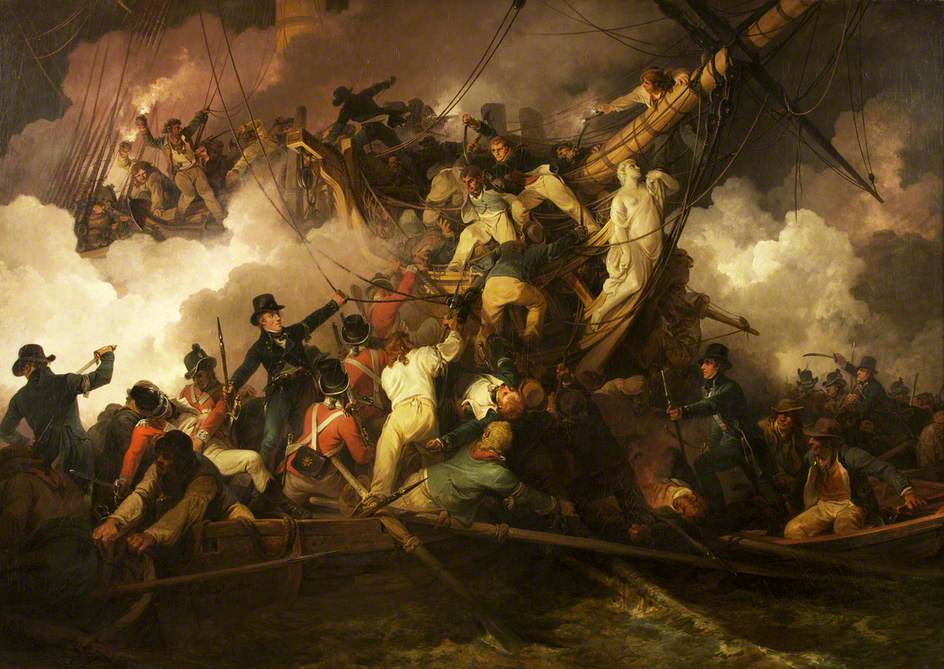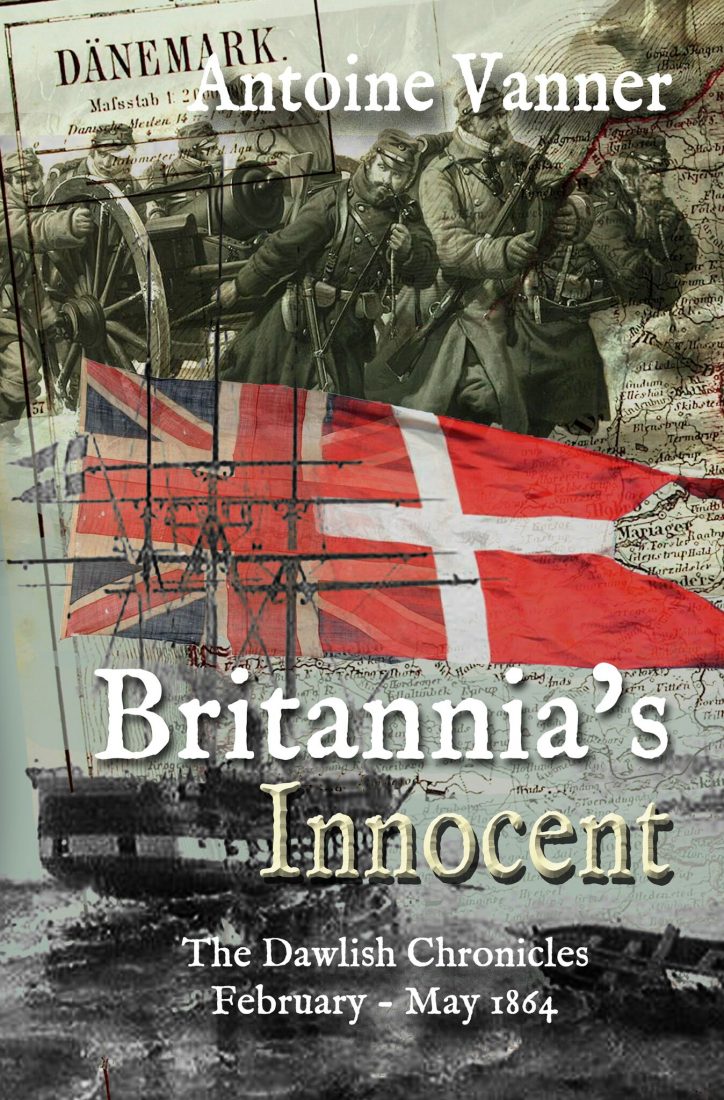 The Capture of the Chevrette, 1801
The Capture of the Chevrette, 1801

While leafing through an 1894 book entitled “The British Fleet” by Commander Charles N. Robinson (Assistant Editor of the Army and Navy Gazette) I came on a copy of the engraving above. It shows a cutting-out mission on July 22nd 1801 in which crews from four Royal Navy ships attacked a French ship in small boats, even while it was moored for protection under the guns of a shore battery at Camaret Bay on the Breton coast. Such cutting-out exploits feature frequently in naval fiction, as they often did in real-life during the Revolutionary and Napoleonic Wars. This engraving, though an artist’s impression, gives an idea of just how brutal – and near suicidal – such actions could be. (The original painting will be found later in this article) As I had not heard of this action previously I searched for more details and was surprised at just how high a price was paid for capture of so small a prize.
The captain of the 20-gun corvette Chevrette, must have regarded his vessel as invulnerable as he sheltered under shore-battery cover. British ships lying offshore on blockade duty included however the frigates HMS Beaulieu, Doris and Uranie, and the ship of the line HMS Robust (74-guns). The Uranie was originally a French ship, and had been renowned for her capture of a British frigate, HMS Thames, in a spirited action in 1793, prior to being herself captured and taken into British service in 1797.

The Uranie, in French service, capturing HMS Thames in 1793
A first attempt at cutting out was made on the night of 20th/21st July by boats from Beaulieu and Doris. This went awry when the surprise was lost and the boats withdrew. The French had however been alerted to the danger and the Chevrette was moved in even closer under the shore batteries. Soldiers were also embarked to add to the corvette’s defence, bringing the total on board up to with a crew of 339, including soldiers who had recently board.
Undeterred, a fresh British attack was mounted on the night of 21st/22nd, with men and boats from the Robust and the Uranie now also joining in. The attacking force now consisted of 280 men carried in 15 boats. Several of these boats lost their way in the darkness so that only nine reached the Chevrette, those on board significantly outnumbered by the seamen and soldiers on board her. The British approach was now detected and fire was opened on them from both the French shore battery and from the Chevrette. The boats closed however with the moored ship – a fact that must have made it impossible for the shore batteries to maintain fire – and, despite furious opposition, a large number of men gained the Chrevette’s deck. Within three minutes of boarding, and as fighting raged, the outnumbered British attackers managed to cut the anchor cable and set sufficient sail for a light breeze to carry the vessel out into the bay. Many of the French, apparently trapped on the waist when the British gained possession of both quarterdeck and forecastle, either jumped overboard or took cover below. The shore batteries kept the Chrevette under fire until she cleared the bay. Here the six missing British boats brought reinforcements, so that possession was assured.

The original painting, by Philippe-Jacques de Loutherbourg (1740-1812) is perhaps the best – and certainly most dramatic – depiction ever of a boarding action. It is located in Bristol Museum and Art Gallery; Supplied by The Public Catalogue Foundation, and licensed under the Creative Commons Attribution-Share Alike 3.0 Unported license
The ferocity of the action was underlined by the high casualties. The French had 92 killed and 62 wounded while the British attackers lost 11 killed, 57 wounded and one missing. It should be borne in mind that some of the wounded might have most likely endured amputations afterwards, and some could have died of infection – the number of dead alone was not the only measure of “the butcher’s bill”. Given that the Chevrette was a small vessel and that her capture would have made no possible impact on the outcome of the war, and that the British casualty rate was almost 25%, the decision to attack looks foolhardy in the extreme. The only justification can be, in hindsight, that attacks of this type were vital in maintain a sense of moral superiority over the French and by so doing increasing their reluctance to break the blockade.
One other, perhaps unworthy, thought does however strike one. Was the desire for prize money a prime motivator on this occasion? One sincerely hopes not.
Britannia’s Innocent
What links war in Denmark in 1864 with the American Civil War?
 1864 – Political folly has brought war upon Denmark. Lacking allies, the country is invaded by the forces of military superpowers Prussia and Austria. Cut off from the main Danish Army, and refusing to use the word ‘retreat’, a resolute commander withdraws northwards. Harried by Austrian cavalry, his forces plod through snow, sleet and mud, their determination not to be defeated increasing with each weary step . . .
1864 – Political folly has brought war upon Denmark. Lacking allies, the country is invaded by the forces of military superpowers Prussia and Austria. Cut off from the main Danish Army, and refusing to use the word ‘retreat’, a resolute commander withdraws northwards. Harried by Austrian cavalry, his forces plod through snow, sleet and mud, their determination not to be defeated increasing with each weary step . . .
Across the Atlantic, civil war rages. It is fought not only on American soil but also on the world’s oceans, as Confederate commerce raiders ravage Union merchant shipping as far away as the East Indies. And now a new raider, a powerful modern ironclad, is nearing completion in a British shipyard. But funds are lacking to pay for her armament and the Union government is pressing Britain to prevent her sailing . . .
But Denmark is not wholly without sympathisers. Britain’s heir to the throne is married to a Danish princess. With his covert backing, British volunteers are ready to fight for the Danes. And the Confederacy is willing to lease the new raider to Denmark for two months if she can be armed as payment, although the Union government is determined to see her sunk . . .
Just returned from Royal Navy service in the West Indies, the young Nicholas Dawlish is induced to volunteer and is plunged into the horrors of a siege, shore-bombardment, raiding and battle in the cold North Sea – notwithstanding divided loyalties . . .
In other books of the Dawlish Chronicles series, Dawlish is met as an experienced and resourceful officer, but in 1864 he is still an innocent. But he will need to learn fast . . .
For amazon.com For amazon.co.uk For amazon.com.au
Below are the eleven Dawlish Chronicles novels published to date, shown in chronological order. All can be read as “stand-alones”. Click on the banner for more information or on the “BOOKS” tab above. All are aailable in Paperback or Kindle format and can be read at no extra charge by Kindle Unlimited or Kindle Prime Subscribers.
Six free short-stories are available for download to your Kindle. Access them by registering for the Dawlish Chronicles mailing list – just click on the banner below. You’ll be kept updated on new books and will receive other free stories at intervals.


